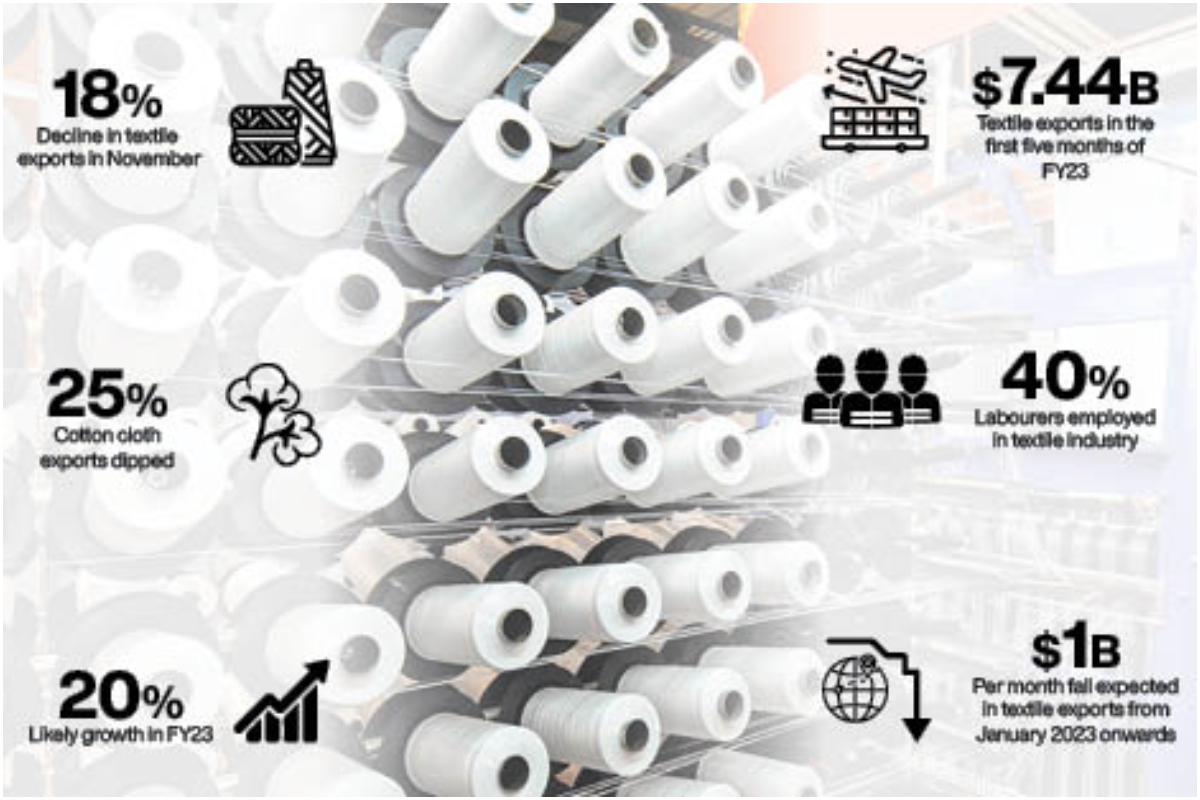
In Dire Straits
The textile units are struggling to survive in these tough times, as the country’s exports declined over 18 per cent to $1.42 billion in November 2022, compared with $1.736 billion in the corresponding month of the last year.
Similarly, cotton cloth exports dipped 25 per cent to $153.7 million during the period under review, as against $204.85 million in November 2021, the data released by the Pakistan Bureau of Statistics (PBS) showed.
However, the All Pakistan Textiles Mills Association (Aptma) had earlier predicted that the country will see around 20 per cent growth in FY23 on a year-on-year (YoY) basis but the declining spree is an alarming trend.
The textile exports had marginally increased on a YoY basis and posted a growth of 8 per cent in July and 9 per cent in August and September 2022.
On a cumulative basis, the textile exports during the first five months of FY23 stood at $7.44 billion, compared with $7.76 billion in the same period of the last year, registering a fall of 4 per cent.
However, on a month-on-month basis, the exports registered a 3.30 per cent growth in November 2022, as the shipment values hovered around $1.35 billion in October 2022, according to the PBS figures.
However, owing to several reasons, including high production costs and rising energy prices, many textile units have temporarily shut down their operations, rendering thousands of workers unemployed, while bringing improvement in the situation seems a distant dream.
Meanwhile, Pakistan’s textile industry is not ready for a trade barrier that is in the making in the Global North.
Recently, the European Union countries reached an agreement on the Carbon Border Adjustment Mechanism (CBAM) to tackle the effects of the climate.
Carbon leakage is a phenomenon; whereby, the companies are relocating to those countries with less stringent policies on carbon to continue manufacturing driven by polluted energy resources. CBAM remains a breakthrough in the fight to curb emissions. It reduces the competitiveness of products with a higher carbon footprint and also helps contain the issue of carbon leakage.
Pakistan must reduce its textile industry carbon footprint. It is the need of the hour to capitalise on this recent development and to establish an effective framework to reduce emissions associated with the textile manufacturing processes.
The textile industry employs around 40 per cent of Pakistan’s industrial labour force. Any hit to the textile industry will translate into job losses for industrial workers on a non-trivial scale, exacerbating the socioeconomic woes.
Moreover, as Pakistani textiles comprise 80 per cent of exports to the EU; it may find it difficult to compete with those countries that have cleaner means to support their textile sector.
Even India, Pakistan’s main competitor across the globe is making efforts to contain emissions by using other renewable resources and to compete with it, we need to move towards cleaner energy resources at a fast pace, otherwise we will have to endure the destruction of climate change and further suffer the economic meltdown.
Recently, the All Pakistan Textile Mills Association (Aptma) wrote a letter to Prime Minister Shehbaz Sharif and warned that the textile exports could fall below $1 billion/month from January 2023 onwards.
Aptma said Pakistan cannot afford losing its principal industry, as it contributes over 67 per cent to the country’s total export earnings and accounts for around 46 per cent of the total manufacturing.
The economic crunch has caused a loss of thousands of jobs so far and, if the people at the helm of affairs fail to take timely remedial measures, many more will be jobless.
All these problems are the result of supply chain disruptions, liquidity constraints, energy shortages and the non-functioning of new projects.
The recent floods in Pakistan destroyed the cotton crop with only five million bales available this year, whereas the industry required 14 million bales. Similarly, the continuous decline in the foreign exchange reserves and the import restrictions have also played their part.
Owing to a significant difference in the regasified liquefied natural gas (RLNG) and natural gas rates being offered to the textile mills in Sindh and Punjab, the Punjab-based industries are becoming unviable and left with no other option but to close down their operations.
As the default is looming large just like Sri Lanka, the Pakistan government should immediately initiate aspiring economic reforms. A default situation always damages the relationship with the investors. Therefore, it is necessary for the authorities to revisit policies and markets to identify hindrances and inefficiencies if we want to bring economic stability and sustainable growth. Pakistan needs to encourage exports, investment and productivity to overcome the economic crisis.
The textile exports are likely to remain subdued because of the dearth of new orders, amid global economic slowdown.
Besides international issues, Pakistan’s textile industry is also facing problems at home such as higher electricity and gas tariffs, rising cost of doing business, etc. The textile industry consumes less than 9 per cent of the overall national gas supply, yet it takes the hit on any nationwide gas cuts, hurting the exports and also bear the highest energy tariffs, not only in the country but also in the region.
This rendered several companies uncompetitive in the international market. Pakistan’s textile industry is paying $9/mmbtu, which is 3.5 times more than Uzbekistan and 1.5 times then Bangladesh.
The World Bank has reported that the poor performance of Pakistan’s trade in recent years is the result of fading away of export competitiveness.
According to the Ease of Doing Business report, Pakistan stands at 108 of the 190 countries. The country remains uncompetitive in the region because of its anti-business policies. The textile sector creates thousands of jobs. The expansion and development of industries reduce unemployment.
Another factor hurting the textile industry is a decline in the cotton cultivation area by over one million acres in 10 years. We have to identify and develop new areas for cotton cultivation. We should also lower our cost of doing business to compete in the international market.
The government should focus on targeted exports and business-friendly policies for the industry to grow and further achieve their targets on an annual basis. Pakistan’s textile sector has immense potential for an economic turnaround and to achieve desired targets.
Catch all the Economic Pulse News, Breaking News Event and Latest News Updates on The BOL News
Download The BOL News App to get the Daily News Update & Live News.








 Read the complete story text.
Read the complete story text. Listen to audio of the story.
Listen to audio of the story.